| THE SECONDARY CHARACTER OF SLATY CLEAVAGE Slaty cleavage refers to the extremely closely spaced, parallel planes of weakness that give a rock like slate its ability to split into very thin, platy layers. |
 | 
Slate is a common roofing material. Taking advantage of the natural planes of weakness within slate (slaty cleavage), it can be split into very thin slabs of uniform thickness. Photo by National Park Service. |
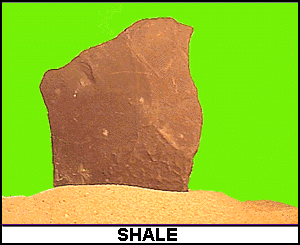 | 
Shale is a very fine-grained sedimentary rock that tends to break into flat, slabby pieces. Photo by NASA. |
| THE MINERALOGY AND TEXTURE OF SHALE AND SLATE
|
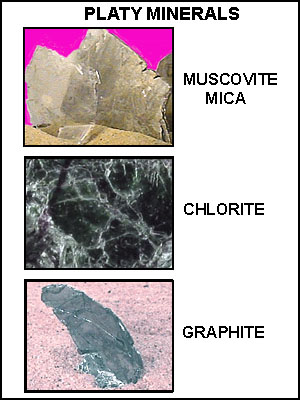
Shale is composed of very fine (sub-microscopic) mineral dust, of which clay is a significant component. Clay occurs as flat flakes which, except for their extremely small size, are similar to flakes of muscovite (shown above).
Slate contains significant quantities of muscovite, chlorite (a green mineral similar to mica) and sometimes graphite, all of which are flaky minerals (shown above). | 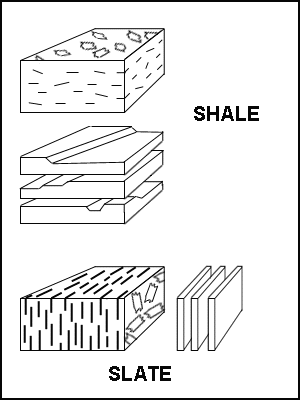
Both shale and slate split into flat slabs. However, slate slabs tend to be thinner and flatter than shale slabs. Both shale and slate have significant quantities of flaky minerals which are oriented parallel to each other. Splitting takes place parallel to the oriented, flaky grains. Because the parallelism of the grains in the slate is more perfect than in the shale, the splitting results in flatter, thinner slabs. |
| GEOLOGISTS' CLAIMS
|
| Geologists claim that slaty cleavage is a secondary structure imposed on the sedimentary rock 'shale'. That is, slate is the metamorphic equivalent of shale. How can the geologists' claims be justified? - That shale is sedimentary.
- That slate is a metamorphic rock formed by the imposition of a secondary structure (slaty cleavage) on shale?
|
| SHALE AS A SEDIMENTARY ROCK Shale is considered sedimentary on the basis of the many primary structures it displays. Here are three examples of such structures:
- Horizontal layering over great distances.
- Mudcracks.
- Fossils.
|
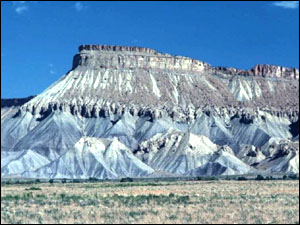
The gentle slopes are composed of horizontal layers of shale. If you look carefully at the hills in the forground, you will see the horizontal, alternating blue and bluish-white layers. Photo by USGS. Horizontal layering is a characteristic of sedimentary rocks.  |
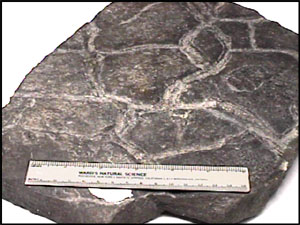
The presence of mudcracks indicates the rock formed at or near the earth's surface.  |

The presence of fossils indicates the rock formed at or near the earth's surface. Photo by Utah Geological Survey. 
|
| THE ORIGIN OF SLATE AND SLATY CLEAVAGE Geologists have come to conclusions about the origin of slate and slaty cleavage based upon observations of their relationship to other rock bodies in the field. |
|
| OBSERVATIONS AND HYPOTHESES |
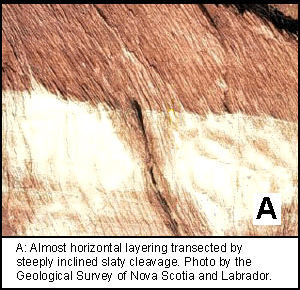 | A: Observation: Slaty cleavage (steeply inclined) traverses almost horizontal layering. |
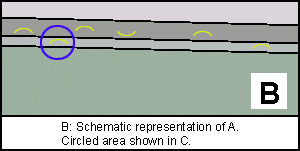 | B: A diagramatic representation of the almost horizontal layering shown in A. As will be seen, the yellow arcs are salt water clam fossils aligned parallel to the layering. Observation: In turbulent ocean water, the most stable position for clam shells to come to rest on the ocean floor is with the bulge facing upward. Most of the yellow arcs have that orientation. Hypothesis:The layers are indeed sedimentary and were deposited on an ocean floor. The circled area is shown enlarged in C.
|
 | C: Observation: A close look at the boundaries between the nearly horizontal layers shows that they are stepped, rather than straight. Comment: This is surprising since layers deposited on the ocean floor should be smooth and straight. Observation: The stepped effect is due to the presence of the slaty cleavage which is (shown by parallel, vertical black lines). Each cleavage slice has been offset slightly with respect to its neighbor. The clam fossils have also been sliced by the cleavage and offset. The area inside the blue circle is shown enlarged in D. |
 | D: Observation: A clam shell that has been 'sliced' and 'offset'. |
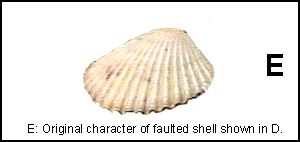 | E: Observation: A picture of a clam shell that has not been 'sliced' and 'offset'. Hypothesis: The 'sliced' and 'offset' clam shell fossils originally looked like this. |
| CONCLUDING HYPOTHESIS: The almost horizontal layering was formed as mud was deposited on the ocean floor. Clams shells accumulated at the same time. The mud-and-shell mixture was turned into rock (a fossiliferous shale).
Subsequently, the shale was sliced into vertical slabs which shifted slightly with respect to each other. The next question to address is: What causes slaty cleavage to develop? |
|